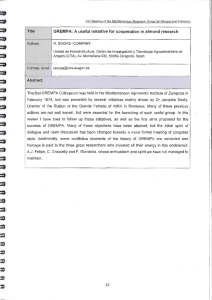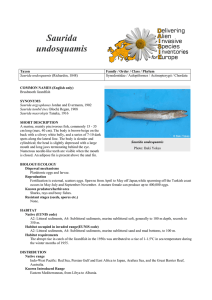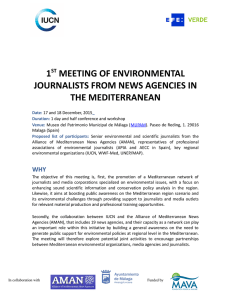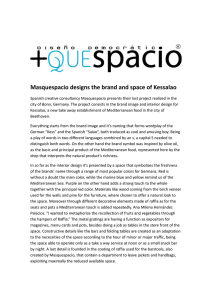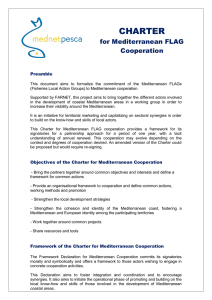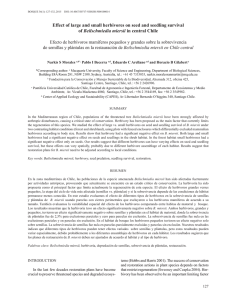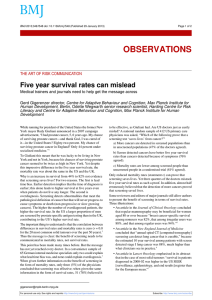applying plant facilitation to forest restoration: a meta
Anuncio
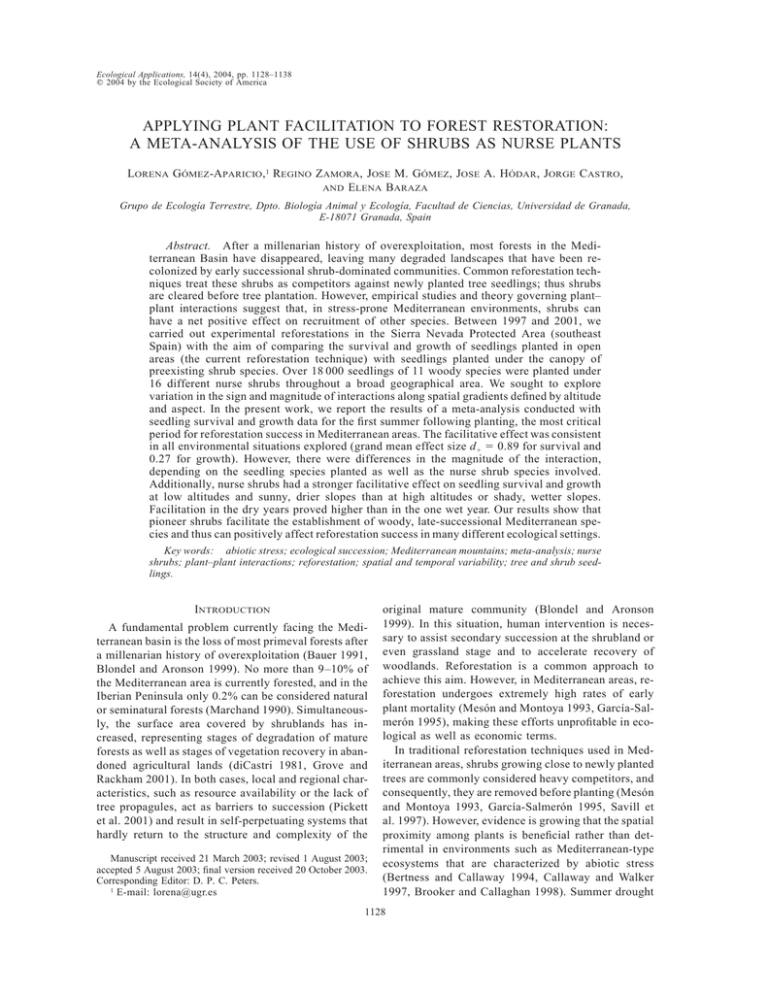
Ecological Applications, 14(4), 2004, pp. 1128–1138 q 2004 by the Ecological Society of America APPLYING PLANT FACILITATION TO FOREST RESTORATION: A META-ANALYSIS OF THE USE OF SHRUBS AS NURSE PLANTS LORENA GÓMEZ-APARICIO,1 REGINO ZAMORA, JOSE M. GÓMEZ, JOSE A. HÓDAR, JORGE CASTRO, AND E LENA BARAZA Grupo de Ecologı́a Terrestre, Dpto. Biologı́a Animal y Ecologı́a, Facultad de Ciencias, Universidad de Granada, E-18071 Granada, Spain Abstract. After a millenarian history of overexploitation, most forests in the Mediterranean Basin have disappeared, leaving many degraded landscapes that have been recolonized by early successional shrub-dominated communities. Common reforestation techniques treat these shrubs as competitors against newly planted tree seedlings; thus shrubs are cleared before tree plantation. However, empirical studies and theory governing plant– plant interactions suggest that, in stress-prone Mediterranean environments, shrubs can have a net positive effect on recruitment of other species. Between 1997 and 2001, we carried out experimental reforestations in the Sierra Nevada Protected Area (southeast Spain) with the aim of comparing the survival and growth of seedlings planted in open areas (the current reforestation technique) with seedlings planted under the canopy of preexisting shrub species. Over 18 000 seedlings of 11 woody species were planted under 16 different nurse shrubs throughout a broad geographical area. We sought to explore variation in the sign and magnitude of interactions along spatial gradients defined by altitude and aspect. In the present work, we report the results of a meta-analysis conducted with seedling survival and growth data for the first summer following planting, the most critical period for reforestation success in Mediterranean areas. The facilitative effect was consistent in all environmental situations explored (grand mean effect size d1 5 0.89 for survival and 0.27 for growth). However, there were differences in the magnitude of the interaction, depending on the seedling species planted as well as the nurse shrub species involved. Additionally, nurse shrubs had a stronger facilitative effect on seedling survival and growth at low altitudes and sunny, drier slopes than at high altitudes or shady, wetter slopes. Facilitation in the dry years proved higher than in the one wet year. Our results show that pioneer shrubs facilitate the establishment of woody, late-successional Mediterranean species and thus can positively affect reforestation success in many different ecological settings. Key words: abiotic stress; ecological succession; Mediterranean mountains; meta-analysis; nurse shrubs; plant–plant interactions; reforestation; spatial and temporal variability; tree and shrub seedlings. INTRODUCTION A fundamental problem currently facing the Mediterranean basin is the loss of most primeval forests after a millenarian history of overexploitation (Bauer 1991, Blondel and Aronson 1999). No more than 9–10% of the Mediterranean area is currently forested, and in the Iberian Peninsula only 0.2% can be considered natural or seminatural forests (Marchand 1990). Simultaneously, the surface area covered by shrublands has increased, representing stages of degradation of mature forests as well as stages of vegetation recovery in abandoned agricultural lands (diCastri 1981, Grove and Rackham 2001). In both cases, local and regional characteristics, such as resource availability or the lack of tree propagules, act as barriers to succession (Pickett et al. 2001) and result in self-perpetuating systems that hardly return to the structure and complexity of the Manuscript received 21 March 2003; revised 1 August 2003; accepted 5 August 2003; final version received 20 October 2003. Corresponding Editor: D. P. C. Peters. 1 E-mail: [email protected] original mature community (Blondel and Aronson 1999). In this situation, human intervention is necessary to assist secondary succession at the shrubland or even grassland stage and to accelerate recovery of woodlands. Reforestation is a common approach to achieve this aim. However, in Mediterranean areas, reforestation undergoes extremely high rates of early plant mortality (Mesón and Montoya 1993, Garcı́a-Salmerón 1995), making these efforts unprofitable in ecological as well as economic terms. In traditional reforestation techniques used in Mediterranean areas, shrubs growing close to newly planted trees are commonly considered heavy competitors, and consequently, they are removed before planting (Mesón and Montoya 1993, Garcı́a-Salmerón 1995, Savill et al. 1997). However, evidence is growing that the spatial proximity among plants is beneficial rather than detrimental in environments such as Mediterranean-type ecosystems that are characterized by abiotic stress (Bertness and Callaway 1994, Callaway and Walker 1997, Brooker and Callaghan 1998). Summer drought 1128 August 2004 SHRUBS FACILITATE FOREST RESTORATION is a main source of stress in Mediterranean environments that limits recruitment of both natural and planted seedlings (Herrera et al. 1994, Rey and Alcántara 2000, Castro et al. 2002). Under such conditions, tree seedlings may benefit from the habitat amelioration by shrubs, which buffer against high radiation and temperatures and can increase soil nutrient and moisture content (Callaway 1995). The survival and performance of plants in Mediterranean-type ecosystems usually improves when associated with neighbors (Pugnaire 1996a, b, Maestre et al. 2001, Callaway et al. 2002), resulting in a positive association of seedlings and saplings of tree species with shrubs (Garcı́a et al. 2000, Gómez et al. 2001a, 2003). As a consequence, the spatial pattern of the Mediterranean vegetation is commonly aggregated (Callaway and Pugnaire 1999, Maestre 2002). Thus, the removal of preestablished shrubs prior to reforestation would not be an appropriate technique to apply in these ecosystems. Environmental conditions in Mediterranean mountains are particularly variable in both time and space (Blondel and Aronson 1999). Their complex orography and high altitudes, together with an unpredictable climate, foster the coexistence of many contrasting ecological scenarios at local scales. Differences in environmental conditions appearing at a scale of meters may cause intense shifts in the net outcome of plant interactions. Facilitation often increases with intensified stress, as has been reported in south-facing vs. west-facing slopes in rocky plant communities (Callaway et al. 1996), in dry vs. mesic adjacent sites in the Chilean matorral (Holmgren et al. 2000), in higher vs. lower depths in coastal ecosystems (Bertness et al. 1999), or in high vs. low altitudes in alpine and semiarid environments (Pugnaire and Luque 2001, Callaway et al. 2002). Interspecific interactions can also vary at the same site between years depending on climatic conditions, although the relationship between climatic variability and the net result of the interaction is still unclear. Some studies report stronger facilitation in dry and hot years compared to relatively benign years (Greenlee and Callaway 1996, Ibañez and Schupp 2001) whereas other studies reached the opposite conclusion (Casper 1996, Tielbörger and Kadmon 2000). Therefore, an understanding of how the interaction between shrubs and tree seedlings varies spatio-temporally is crucial to assessing the generality of the utility of shrubs as nurse plants for forest regeneration and restoration. According to the above theoretical and empirical framework, we hypothesize that an alternative reforestation technique using shrubs as planting microsites in Mediterranean areas would give better results (in terms of seedling survival and growth) than would standard techniques using open spaces without vegetation, especially in hot and dry sites and years. To test this hypothesis, between 1997 and 2001, we carried out experimental reforestations in the Sierra Nevada moun- 1129 tains in southeast Spain, encompassing the broad range of abiotic as well as biotic conditions provided by this Mediterranean high mountain. We considered both variability in space as well as in time, a fundamental but barely explored combination of factors, in order to understand the nature and strength of plant–plant interactions related to woody plant establishment. Specifically, we addressed the following questions: (1) How does the use of shrubs as microsites for planting improve tree seedling survival and growth? (2) How does the effect of shrubs on seedling survival and growth vary depending on the shrub and tree species? (3) How do the sign and magnitude of the interaction between shrubs and woody seedlings depend on spatial characteristics of the study site, such as altitude and aspect? (4) How do the sign and magnitude of the interaction between shrubs and woody seedlings depend on climatic conditions in the year of planting? METHODS Study area and species This study was carried out in the Sierra Nevada mountains, southeast Spain. The general climate is Mediterranean, characterized by cold winters and hot summers with heavy summer drought (July–August). Rainfall is concentrated mainly in autumn and spring. In these mountains, temperature drops and rainfall increases with altitude, with areas below 1400 m above sea level (asl) having a dry climate with precipitation of ,600 mm/yr, while areas above this threshold have a subhumid climate with precipitation between 600 and 1000 mm/yr (Garcı́a-Canseco 2001). Additionally, the complex orography of the mountains causes strong climatic contrasts between the sunny and dry south-facing slopes and the shaded and wetter north-facing slopes (Rodrı́guez-Martı́nez and Martı́n-Vivaldi 1996). From a temporal perspective, in southern Spain, annual rainfall fluctuates markedly, making it possible to identify dry and wet years (Rodó and Comı́n 2001). The experiments were conducted in seven sites of the Sierra Nevada mountains (Table 1), for a total of 36 1-ha plots (see Appendix). The bedrock was siliceous in two study zones and calcareous in five, and in all cases the predominant soils were regosols and cambisols (Delgado et al. 1989). All study areas were burned within the last 20 years. Consequently, current vegetation is pioneer shrubs (.60% of cover in all cases) mixed with annual and perennial grasses and herbs, together with some surviving isolated trees. The most abundant shrub species in every study site are shown in Table 1. We planted seedlings of the following target shrub and tree species: Crataegus monogyna, Rhamnus alaternus, Retama sphaerocarpa, Quercus faginea, Q. ilex, Q. pyrenaica, Pinus halepensis, P. nigra, P. sylvestris var. nevadensis, and Acer opalus subsp. granatense. These species are either commonly found in LORENA GÓMEZ-APARICIO ET AL. 1130 TABLE 1. Ecological Applications Vol. 14, No. 4 Main characteristics of the seven study sites in the Sierra Nevada mountains, southeast Spain. Study site Coordinates Altitude (m†) Aspect Soil Loma Panaderos 378059 N 38289 W 1850 N–NE calcareous Cortijuela 378059 N 38289 W 1650 N–NE calcareous Rosales Lanjarón 378049 N 38309 W 1800 368569 N 38299 W 1230–1900 S S calcareous siliceous Lújar 368529 N 38239 W N–NE calcareous Válor 378029 N 38069 W 1820–2000 S siliceous Huétor 378159 N 38279 W N–NE calcareous 465 1400 Main shrub species Salvia lavandulifolia, Ononis aragonensis, Genista scorpius, Crataegus monogyna, Berberis hispanica, Prunus ramburii S. lavandulifolia, C. monogyna, B. hispanica, P. ramburii, Thymus mastichina, Echinospartium bosissiere, Genista cinerea Cistus albidus, S. lavadulifolia Genista umbellata, Cistus monspeliensis, Ulex parviflorus, Santolina canescens, Artemisia campestris, Thymus vulgaris Rosmarinus officinalis, C. monspeliensis, U. parviflorus S. canescens, Festuca sp., Adenocarpus decorticans, A. campestris U. parviflorus, C. monogyna Notes: Main shrub species represent species covering .5% of the study area. † Above sea level. natural forests in Mediterranean mountains (e.g., C. monogyna, R. alaternus, P. halepensis, P. nigra, Q. ilex, Q. pyrenaica) or are endemic species of interest in conservation (P. sylvestris var. nevadensis and A. opalus subsp. granatense). Experimental design Seedlings one or two years old were planted in spring (March–April) between 1997 and 2001 at each study site using two reforestation techniques: (1) a traditional technique of planting target seedlings in open interspaces without vegetation (Open microsite) and (2) an alternative technique of planting seedlings under the canopy of shrubs (Shrub microsite) intermingled with the open microsites. Seedlings, provided by the Junta de Andalucı́a (Consejerı́a de Medio Ambiente, Granada, Spain), were grown in nurseries under similar conditions. In the case of Acer opalus subsp. granatense and Pinus sylvestris var. nevadensis, rarely available in nurseries, seedlings came from seeds collected from adults near the planting sites and seeded in a nursery located at La Cortijuela Botanical Garden (Sierra Nevada National Park). The most abundant shrub species at each site were chosen as nurse plants. In total, we used 16 nurse plant species and 11 target species, for a total of 146 different plot–nurse shrub– target species combinations (experimental cases, hereafter; see Appendix). Between 50 and 60 individually tagged seedlings were planted per plot–nurse shrub– target species combination. In both Shrub and Open microsites, an automatic auger 12 cm in diameter was used to dig the planting holes 40 cm deep in an attempt to minimize disturbance to nurse and soil structure. Seedlings were examined in June, before the summer drought, and those that died from transplant shock were excluded from the experiment. By September–October, following first autumn rains, we recorded two variables per seedling: (1) survival and the cause of mortality in case of death; and (2) growth, quantified as the elongation of the apical shoot after the first growing season. The data set was sorted according to five grouping variables to respond to the specific questions posed in this study: 1) Target species were classified into four functional groups based on life habits and ecological similarity: shrubs (which included Juniperus oxycedrus, Rhamnus alaternus, Crataegus monogyna, and Retama sphaerocarpa), deciduous (which included Acer opalus subsp. granatense, Quercus pyrenaica, and Quercus faginea), Mediterranean lowland evergreen (which included Quercus ilex and Pinus halepensis) and mountain pines (which included Pinus nigra and Pinus sylvestris var. nevadensis). 2) Nurse shrubs were classified into four functional groups based on architectural and ecological traits: (1) legumes (Ulex parviflorus, Genista versicolor, Genista umbellata, Ononis aragonensis, and Adenocarpus decorticans); (2) small shrubs (Salvia lavandulifolia, Thymus mastichina, Thymus vulgaris, Rosmarinus officinalis, Santolina canescens, and Artemisia campestris); (3) deciduous spiny shrubs (Prunus ramburii, Crataegus monogyna, and Berberis hispanica); and (4) rockroses (Cistus albidus and Cistus monspeliensis). 3) Altitude, by classifying experimental cases into both low (below 1400 m asl) and high altitude sites (above 1400 m asl). 4) Aspect, by classifying experimental cases into two classes: sunny (south-facing slopes) or shady (northfacing slopes). 5) Year, based on the start of the study (1997, 2000, 2001). Experimental cases conducted in 1998 were not included in this analysis because of their low number (n 5 3). August 2004 SHRUBS FACILITATE FOREST RESTORATION Data analysis The effect of planting technique (Open vs. Shrub microsites) in reforestation success was analyzed using meta-analysis. We employed this procedure because the heterogeneity in the different experiments performed with respect to several factors, such as initial conditions, timing, and nurse and tree identity, did not fulfill the requirements of ordinary statistical analyses. Nevertheless, meta-analysis is a powerful statistical tool to synthesize results from independent studies beyond their differences, emphasizing patterns that are not obvious looking at single studies (Goldberg et al. 1999). Specifically, when sample sizes are small or the intensity of an effect is low (as it was in some of our studies), meta-analysis controls for Type II statistical error (Arnqvist and Wooster 1995). This characteristic of meta-analytical techniques has much relevance in the field of applied ecology where management decisions based on erroneous research results can have significant negative repercussions. Prior to the meta-analysis, we summarized our database by the calculation of the relative neighbor effect index (RNE; sensu Markham and Chanway [1996]) for each experimental case (either for seedling survival or growth). This index is an estimation of the magnitude and sign of the interspecific interaction and ranges from 21 to 1, with negative values indicating facilitation between neighbors and positive values indicating competition. We used RNE instead of the common relative competitive intensity (RCI) because RCI has no minimum value and therefore gives extreme negative values when plant performance is greater in the presence than in the absence of neighbors. For seedling survival, RNE was calculated as the difference in survival with and without nurse shrubs relative to the case with the greatest survival in the pair. For growth, RNE was calculated using means of seedling growth in each plot. Because survival and growth can be influenced by the initial seedling height, we checked the correlation between them, which proved to be nonsignificant. Thus, we deleted initial seedling height data throughout the study. All indices, as well as subsequent statistical analyses, were performed using one-year survival and growth data in order to standardize time scales between experiments. Our previous experience shows that, in Mediterranean environments, drought during the first summer after planting is the main mortality factor for seedling survival (with mortalities of even 90% of the individuals planted), and so the success of a reforestation can be properly evaluated on the basis of firstsummer results (Vilagrosa et al. 1997, Rey-Benayas 1998, Maestre et al. 2001, Castro et al. 2002). We used the mixed-model procedure, which appears to be more accurate than the fixed-model because it assumes random variation between studies within a class instead of the sharing of a single true effect size (Gurevitch and Hedges 2001). We chose the standard- 1131 ized difference between means (d index) to estimate the effect of the presence of shrubs on two response variables: seedling survival and seedling growth. To calculate the effect sizes using survival data, we grouped the experimental cases carried out in the same study site and year with the same target and nurse shrub species and calculated the means of the two groups (experimental and controls) as well as the standard deviations for these means. To calculate the effect sizes using growth data, we used each of the 146 experimental cases independently with the condition that at least two individuals survived in both treatments. The magnitudes of effect sizes were interpreted sensu Cohen (1969). Sensitivity analyses were used to control dependence between data (Gates 2002). We performed an additional analysis restricting the data to one data point for each study site. The effect of shrubs on planted seedlings was first assessed for the entire data set. We then evaluated the homogeneity of results among groups of each of the five grouping variables by using the Q statistic (Hedges and Olkin 1985, Cooper and Hedges 1994). We found a significant covariation between some grouping variables: P. halepensis and shrubs were always at low altitudes, whereas deciduous species P. nigra and P. sylvestris var. nevadensis were always at high altitudes (x2 5 44.37, df 5 3, P , 0.001). Therefore, the difference between altitudes in the effect of shrubs may reflect differences between target species. To correct for this, we also examined altitudinal effects for Q. ilex, the only species appearing at both altitudes. RESULTS Survival In 109 of the 146 experimental cases (75%), shrubs increased seedling survival (negative RNE values). A neutral interaction (RNE 5 0) was found in 8 cases (5%), whereas only in 29 (20%) of the cases there was a negative RNE indicating antagonism (Fig. 1a). The result from this ‘‘vote-counting’’ approach was consistent with results from the meta-analysis. Across all studies, shrubs had a large positive significant effect on seedling survival, with a grand mean effect size of d1 5 0.89 (CI 5 0.51–1.27). The sensitivity analysis showed a similar general result at the study-site level, but with a substantially higher absolute total effect size (d1 5 1.15; CI 5 0.49–1.81). Thus, we can assume that interdependence caused little bias. In 98% of the cases, the cause of mortality was summer drought, whereas the remaining 2% was attributable to herbivore damage (trampling, uprooting, browsing). The effect of shrubs significantly differed between target species (QB 5 49.55, df 5 3, P , 0.0001). Whereas the effect was significantly different from zero for Mediterranean evergreens, deciduous species, and shrubs, it was not significant for mountain pines (Fig. 2a). The magnitude of the effect varied from low for 1132 Ecological Applications Vol. 14, No. 4 LORENA GÓMEZ-APARICIO ET AL. effect both in the sunny group and in the shady group, the effect size being significantly larger (QB 5 43.59, df 5 1, P , 0.0001) in the sunny slopes than in the shady ones (Fig. 2d). Comparisons between years revealed a significant effect of shrubs on seedling survival in 2000 and 2001 (‘‘dry years’’), but not in 1997 (‘‘wet year’’) (QB 5 48.51, df 5 2, P , 0.0001; Fig. 2e). Growth FIG. 1. Summary of results from the experimental cases. Relative neighbor effect (RNE) is an estimation of the magnitude of the effect of shrubs on seedling survival and growth. This index ranges from 21 to 1, with negative values indicating facilitation and positive values indicating competition. Eight cases were removed from the figure because RNE 5 0. The study was carried out in the Sierra Nevada mountains, southeast Spain. mountain pines, through large for deciduous species, to very large for Mediterranean evergreens and shrubs. Between nurses, the effect varied from significantly large and positive for legumes and small shrubs (facilitation), through nonsignificantly medium and positive for deciduous spiny, to significantly large and negative for rockroses (antagonism; Fig. 2b). On average, shrubs provided stronger facilitation at the low altitude than at the high altitude (QB 5 41.42, df 5 1, P , 0.0001; Fig. 2c). The same result was found when the relative contribution of altitude to the variation in the shrub effect was analyzed for Q. ilex alone, with a significantly higher effect size at the low altitude than at the high altitude (QB 5 14.92, df 5 1, P , 0.0001). Facilitation by shrubs had a significant The RNE for growth could be calculated only in 68% of the experimental cases, where more than one seedling survived. Of these cases, 76% showed higher growth in Shrubs compared to Open (negative RNE values), and the remaining 24% reported higher growth in Open (positive RNE; Fig. 1b). These results also agreed with those from the meta-analysis. On pooling studies, we found a significant but small mean effect of shrubs on seedling growth on average (d1 5 0.27; CI 5 0.15–0.39). Seedlings planted under shrubs grew more during the first growing season than did seedlings planted in open areas. The sensitivity analysis showed a similar general result at the study-site level (d1 5 0.3; CI 5 0.05–0.55). Thus, interdependence did not bias the results. There were significant differences between target groups in the effect of shrubs on growth (QB 5 82.20, 1 df, P , 0.0001); statistically significant differences were only found for Mediterranean evergreen and deciduous species (Fig. 3a). Among nurses, the effect was significant for legumes, stunted and spiny species, but not for rockroses; legumes registered the highest values of any group (Fig. 3b). As in survival, the effect was significantly larger at the low than at the high altitude (QB 5 59.34, 1 df, P , 0.0001; Fig. 3c). Significant differences were found between aspect categories (QB 5 84.49, 1 df, P , 0.0001), both showing a small effect of shrubs over growth (Fig. 3d). Finally, the effect of shrubs varied from nonsignificant in the wet year of 1997 to significantly positive in the dry years of 2000 and 2001 (QB 5 98.03, 2 df, P , 0.0001), when seedlings planted under shrubs grew more than did seedlings planted in open areas (Fig. 3e). DISCUSSION Our results demonstrated that pioneer shrubs have a generally positive effect on woody seedling survival and initial growth in Mediterranean mountains. Seedling survival under shrubs more than doubled in comparison to Open microsites and even up to fourfold in some experimental cases (see Appendix). Of our 146 experimental cases, less than 20% showed positive RNE for survival (indicating competitive interactions). In most cases, RNE was lower than 0.2, showing a very weak negative effect. Similarly, in 76% of the experimental cases seedlings planted under shrubs grew more than did seedlings planted in open areas (giving August 2004 SHRUBS FACILITATE FOREST RESTORATION 1133 FIG. 2. Results of the mixed model for survival. Values reported are the mean effect size (d1) and the 95% CI. The significance (P) of the Q statistic for the difference between groups in the effect of nurse shrubs on survival is given. See Methods for a description of the grouping variables. a negative RNE). Therefore, we found a consistent beneficial effect in both survival and initial growth, in contrast to studies that have reported a negative nurse effect in seedling growth, despite the positive effects at other life cycle stages (Holzapfel and Mahall 1999, Kitzberger et al. 2000). These results agree with the hypothesis that there is little competition between shrubs and tree seedlings in the Mediterranean Basin (Vilá and Sardans 1999). Thus, our experiments show that facilitation between shrubs and tree seedlings in Mediterranean environments is not a local or sporadic phenomenon restricted to a few species assemblages and environmental conditions, but a more widespread phenomenon. From a conceptual standpoint, these results show that pioneer shrubs benefit the establishment of woody, late-successional species (Clements 1916, 1134 LORENA GÓMEZ-APARICIO ET AL. Ecological Applications Vol. 14, No. 4 FIG. 3. Results of the mixed model for growth. Values reported are the mean effect size (d1) and the 95% CI. The significance (P) of the Q statistic for the difference between groups in the effect of nurse shrubs on growth is given. See Methods for a description of the grouping variables. Addicot 1984), according to the model of succession by facilitation (Connell and Slatyer 1977). The role of the interacting species in the net effect of shrubs We found relevant differences between target species in their response to the presence of nurse shrubs. Among trees, Quercus spp. and Acer opalus subsp. granatense showed the greatest response both for survival and growth, possibly as a consequence of being late-successional, shade-tolerant species (Zavala et al. 2000, Gómez et al. 2001b). Montane pines had the lowest response in accordance with their shade-intolerant nature (Ceballos and Ruı́z de la Torre 1971, Ni- August 2004 SHRUBS FACILITATE FOREST RESTORATION 1135 FIG. 4. Variability in summer abiotic conditions among the three years of the study: (left-hand panel) soil water content (percentage by volume); (right-hand panel) rainfall (bars; left-hand axis) and mean maximum temperature (filled circles; right-hand axis). Climatic data were obtained at a meteorological station located in La Cortijuela Botanical Garden, Sierra Nevada National Park, Granada, Spain. This meteorological station is situated in the center of the geographical area including all the study sites, representing the general climatic conditions in Sierra Nevada mountains. Volumetric soil water content was recorded in an adjacent area at 15-cm depth during the first week of August using ThetaProbe sensors (Delta-T Devices, Cambridge, UK). kolov and Helmisaari 1992), although association with shrubs was still beneficial, given the harsh conditions of Mediterranean summer (Gómez et al. 2001a, Castro et al. 2002). However, shrub seedlings responded more than any tree species to the presence of nurse shrubs, with Rhamnus alaternus and Crataegus monogyna showing the greatest and Retama sphaerocarpa the lowest increase in survival and growth (see Appendix). This result, together with the higher values of survival in comparison to any other target species, makes the planting of late-successional shrubs under primary successional shrubs the most effective way of accelerating succession in degraded sites where the direct recovery of the tree cover can be very difficult, if not impossible. Our work also demonstrates differences between shrubs in their facilitative effect. The magnitude and sign of the nurse effect on seedling survival varied from large and positive for legumes and small shrubs, through medium and positive for deciduous spiny shrubs, to large and negative for rockroses. The differential effect of nurse shrubs may be related to characteristics of the functional groups. Legumes may increase survival and growth by improving soil nutrients composition due to nitrogen fixation, a scarce nutrient in Mediterranean soils (Callaway 1995, Alpert and Mooney 1996, Franco-Pizaña et al. 1996). On the other hand, radiation during summer in Mediterranean environments is usually excessive, causing photoinhibition of photosynthesis in many plant species (Valladares 2003). In this context, shrub canopy shade can favor seedling performance by reducing radiation in comparison to open areas. In fact, additional experiments conducted in two of the study zones included in the meta-analysis (Gómez et al. 2001b) show that the modification of the microclimate under the canopy of the nurses (e.g., lower radiation and temperature and higher atmosphere and soil humidity) is a main facil- itative mechanism of woody seedling establishment (see also Rey-Benayas [1998], Maestre [2002], ReyBenayas et al. [2002]). Finally, in the case of rockroses, the negative effect on the survival of target species is presumably due to allelopathic leachates characteristic of this family (Robles et al. 1999), particularly for Cistus albidus. Although the grouping of experimental cases that involved the use of meta-analytical techniques prevented the analysis of differences at the species level, these results show that the identity of the nurses matters. This should be taken into account when designing reforestation programs, in order to choose the nurse shrub species that maximize survival probabilities. The importance of environmental variability in plant–plant interactions The facilitative effect was consistent in all the environmental situations explored. However, as predicted by our initial hypothesis, the strength of the interaction was significantly lower (and not statistically significant) in the plantings carried out in the wet year (1997) than in the two dry years (2000, 2001). The summer of 1997 was mild and wet compared to the other summers of the study period, and, in accordance, soil water content in the middle of the summer was significantly greater in 1997 than in the other two years (Fig. 4). This water availability in the soil, although limited, may have relieved stressed plants in 1997, helping them to survive until the arrival of autumn rains. Consequently, the benefit of living in the shade of shrubs was less evident in the wetter 1997 than in the drier 2000 and 2001. With respect to the spatial gradient, the strength of the positive interaction was significantly higher at low altitudes and sunny slopes than at high altitudes or shady slopes. These results indicated a shift in the bal- 1136 LORENA GÓMEZ-APARICIO ET AL. ance of competitive vs. facilitative intensity on stress gradients (Bertness and Callaway 1994, Bruno et al. 2003). At low elevation and sunny slopes, low precipitation and high temperatures result in an intense summer drought, limiting seedling survival and growth more than does resource acquisition. Alleviation of such severe stress by nurse shrubs may benefit seedlings, outweighing any effects of their competition for resources (Callaway and Walker 1997). On the contrary, at high elevations and shady slopes, with lower summer temperatures and higher precipitation (and thus less intense summer drought), the abiotic environment barely limits the uptake of resources for plants, and consequently the positive effects of shrubs is less notable (Callaway and Walker 1997). In conclusion, the higher the temperature and irradiance in open areas, the more important the protection of shrubs can be for a good water and temperature balance of the seedlings and thus the stronger the facilitative effect on their survival and initial growth. Consequently, sites and years with stressful summer droughts promise the best advantage of nurse plants for the recovery of degraded vegetation (Whisenant 1999, Pickett et al. 2001). In these stressful scenarios, the presence of a habitat-modifying pioneer shrub may enhance species diversity by providing structural refuge to a broad array of woody species (Hacker and Gaines 1997, Stachowicz 2001). Additionally, by their positive effect in a very sensitive life history stage of woody species (seedling), habitat modifiers can increase the regional and local distribution of plants, allowing woody species to colonize a broad range of ecological conditions. Given that nurse plants facilitated some woody species more than others, pioneer shrubs in Mediterranean ecosystems could be considered ‘‘foundation species’’ (Dayton 1972) or ‘‘ecosystem engineers’’ (Jones et al. 1994) able to influence the species composition, abundance, and the spatial structure of the plant community. Management implications Our experimental results have clearly shown that the use of nurse shrubs facilitates seedling establishment in many different ecological settings in Mediterranean mountains (altitude, exposure, successional phase of the preexisting vegetation, level of local environmental stress). Although we monitored one-year survival, the benefit of planting seedlings under shrubs could be translated beyond this stage to sapling or reproductive stages, since natural regeneration in Mediterranean ecosystems is mainly limited at the seedling stage (Herrera et al. 1994, Rey and Alcantara 2000, Gómez 2004), and experimental reforestations reveal the bottleneck of first-summer mortality (Maestre et al. 2001, Castro et al. 2002, 2004). Since most shrub species studied acted as nurses and most planted species were effectively facilitated, this technique could be used to design multispecific refor- Ecological Applications Vol. 14, No. 4 estations. To plant many woody species would avoid problems derived from monospecific plantations such as fire propagation (Moreno 1999) or soil impoverishment (Scott et al. 1999) and additionally would increase the diversity and heterogeneity of the recovered woodlands. Moreover, since the response of shrub seedlings to the presence of a nurse plant was larger than the response of tree seedlings, this technique could be used to design a two-phase reforestation strategy, mimicking the natural process. During the first phase, shrubs and sun-tolerant early successional trees would be planted in association with pioneer shrubs, and in a second phase the shade-tolerant late successional trees would be introduced under the canopy of the former ones. Our study implies that the removal of shrubs is not appropriate for reforestation in Mediterranean mountains. This traditional procedure is rooted in techniques developed in Central and Northern Europe (Groome 1989, Bauer 1991), where summer mesic climatic conditions and dense plant cover often result in competition for light and nutrients. This ecological context strongly differs from Mediterranean environments, where stressful conditions, primarily summer drought, severely limit the uptake of resources by the plant, allowing habitat amelioration provided by pioneer shrubs to become the major determinant of spatial distribution of woody seedlings. Therefore, a new paradigm for the science of restoration of Mediterranean forests, based on the natural spatial patterns of regeneration of woody vegetation (with shrubs as microsites for recruitment), emerges from the results of the present work as well as other previous studies (Maestre et al. 2001, 2002, Castro et al. 2002). Furthermore, given that the facilitative effect increases with abiotic stress, this technique might be more relevant under the predicted rise in temperatures, dryness, and rainfall variability (with more episodes of drought) for the Mediterranean region under global warming (IPCC 2001). Thus, benefits of this technique will be greater in coming years under a scenario of climatic change. ACKNOWLEDGMENTS We thank the Consejerı́a de Medio Ambiente, Junta de Andalucı́a, and the Direction of the National Park of Sierra Nevada for permission to field work, constant support and facilities. We are also especially grateful to Empresa de Transformación Agraria S.A. (TRAGSA) for carrying out the experimental reforestation. We thank Sergio de Haro and several students for field assistance. David Nesbitt looked over the English version of the manuscript. This study was supported by a PFPU-MECD grant to L. G. and PFPI-MCYT to E. B. and projects FEDER 1FD97-0743-CO3-02 and REN 20014552-E from MCYT. LITERATURE CITED Addicot, J. H. 1984. Mutualistic interactions in population and community processes. Pages 437–455 in P. W. Price, C. N. Slobodchikoff, and W. S. Gauss, editors. A new ecology: novel approaches to interactive systems. Wiley, New York, New York, USA. Alpert, P., and H. A. Mooney. 1996. Resource heterogeneity generated by shrubs and topography on coastal sand dunes. Vegetatio 122:83–93. August 2004 SHRUBS FACILITATE FOREST RESTORATION Arnqvist, G., and D. Wooster. 1995. Meta-analysis: synthesizing research findings in ecology and evolution. Trends in Ecology and Evolution 10:236–240. Bauer, E. 1991. Los montes de España en la historia. Second edition. Ministerio de Agricultura y Pesca, Madrid, Spain. Bertness, M. D., and R. M. Callaway. 1994. Positive interactions in communities. Trends in Ecology and Evolution 9:191–193. Bertness, M. D., G. H. Leonard, J. M. Levine, P. R. Schmidt, and A. O. Ingraham. 1999. Testing the relative contribution of positive and negative interactions in rocky intertidal communities. Ecology 80:2711–2726. Blondel, J., and J. Aronson. 1999. Biology and wildlife in the Mediterranean region. Oxford University Press, Oxford, UK. Brooker, R. W., and T. V. Callaghan. 1998. The balance between positive and negative interactions and its relationship to environmental gradients: a model. Oikos 81:196–207. Bruno, J. F., J. J. Stachowicz, and M. D. Bertness. 2003. Inclusion of facilitation into ecological theory. Trends in Ecology and Evolution 30, in press. Callaway, R. M. 1995. Positive interactions among plants. Botanical Review 61:306–349. Callaway, R. M., E. H. DeLucia, D. Moore, R. Nowak, and W. H. Schlesinger. 1996. Competition and facilitation: contrasting effects of Artemisia tridentata on desert vs. montane pines. Ecology 77:2130–2141. Callaway, R. M., and F. I. Pugnaire. 1999. Facilitation in plant communities. Pages 623–648 in F. I. Pugnaire and F. Valladares, editors. Handbook of functional plant ecology. Marcel Dekker, New York, New York, USA. Callaway, R. M., and L. R. Walker. 1997. Competition and facilitation: a synthetic approach to interactions in plant communities. Ecology 78:1958–1965. Callaway, R. M., et al. 2002. Positive interactions among alpine plants increase with stress. Nature 417:844–848. Casper, B. B. 1996. Demographic consequences of drought in the herbaceous perennial Cryptantha flava: effects of density, associations with shrubs, and plant size. Oecologia 106:144–152. Castro, J., R. Zamora, J. A. Hódar, and J. M. Gómez. 2002. Use of shrubs as nurse plants: a new technique for reforestation in Mediterranean mountains. Restoration Ecology 10:297–305. Castro, J., R. Zamora, J. A. Hódar, J. M. Gómez, and L. Gómez-Aparicio. 2004. Benefits of using shrubs as nurse plants for reforestation in Mediterranean mountains: a 4year study. Restoration Ecology, in press. Ceballos, L., and J. Ruiz de la Torre. 1971. Árboles y arbustos de la España peninsular. Instituto Forestal de Investigaciones y Experiencias. Madrid, Spain. Clements, F. E. 1916. Plant succession. Carnegie Institution of Washington Publication 242. Cohen, J. 1969. Statistical power analysis for the behavioural sciences. Academic Press, New York, New York, USA. Connell, J. H., and R. O. Slatyer. 1977. Mechanisms of succession in natural communities and their role in community stability and organization. American Naturalist 111:1119– 1144. Cooper, H., and L. Hedges. 1994. The handbook of research synthesis. Russell Sage Foundation, New York, New York, USA. Dayton, P. K. 1972. Toward an understanding of community resilience and the potential effects of enrichment to the benthos at McMurdo Sound, Antarctica. Pages 81–95 in B. C. Parker, editor. Proceedings of the colloquium on conservation problems in Antarctica. Allen Press, Lawrence, Kansas, USA. Delgado, R., G. Delgado, J. Párraga, E. Gámiz, M. Sánchez, and M. A. Tenorio. 1989. Mapa de suelos, hoja 1027 (Güe- 1137 jar-Sierra). Instituto para la Conservación de la Naturaleza, Madrid, Spain. di Castri, F. 1981. Mediterranean-type shrublands of the world. Pages 1–52 in F. di Castri, D. W. Goodall, and R. L. Specht, editors. Ecosystems of the world 11: Mediterranean-type shrublands. Elsevier, Amsterdam, The Netherlands. Franco-Pizaña, J. G., T. E. Fulbright, D. T. Gardiner, and A. R. Tipton. 1996. Shrub emergence and seedling growth in microenvironments created by Prosopis glandulosa. Journal of Vegetation Science 7:257–264. Garcı́a, D., R. Zamora, J. A. Hódar, J. M. Gómez, and J. Castro. 2000. Yew (Taxus baccata L.) regeneration is facilitated by fleshy-fruited shrubs in Mediterranean environments. Biological Conservation 95:31–38. Garcı́a-Canseco, V. 2001. Parque Nacional de Sierra Nevada. Canseco Editors, Talavera de la Reina, Spain. Garcı́a-Salmeron, J. 1995. Manual de repoblaciones forestales II. Escuela Técnica Superior de Ingenieros de Montes, Madrid, Spain. Gates, S. 2002. Review of methodology of quantitative reviews using meta-analysis in ecology. Journal of Animal Ecology 71:547–557. Goldberg, D. E., T. Rajaniemi, J. Gurevitch, and A. StewartOaten. 1999. Empirical approaches to quantifying interaction intensity: competition and facilitation along productivity gradients. Ecology 80:1118–1131. Gómez, J. M. 2004. Importance of burial and microhabitat on Quercus ilex early recruitment: non-additive effects on multiple demographic processes. Plant Ecology, in press. Gómez, J. M., D. Garcı́a, and R. Zamora. 2003. Impact of vertebrate acorn- and seedling-predators on a Mediterranean Quercus pyrenaica forest. Forest Ecology and Management 180:125–134. Gómez, J. M., L. Gómez, R. Zamora, and J. Montes. 2001a. Problemas de regeneración de especies forestales autóctonas en el espacio natural protegido de Sierra Nevada. Pages 212–218 in Montes para la sociedad de un nuevo milenio. Volume 6. Ed. Coria Gráfica, Sevilla, Spain. Gómez, L., R. Zamora, J. A. Hódar, J. M. Gómez, and J. Castro. 2001b. Facilitation of tree seedlings by shrubs in Sierra Nevada (SE Spain): disentangling the mechanisms. Pages 395–400 in K. Radoglou, editor. Forest research: a challenge for an integrated european approach. National Agricultural Research Foundation, Forest Research Institute, Thessaloniki, Greece. Greenlee, J., and R. M. Callaway. 1996. Effects of abiotic stress on the relative importance of interference and facilitation in montane bunchgrass communities in western Montana. American Naturalist 148:386–396. Groome, H. 1989. Historia de la polı́tica forestal. Pages 137– 149 in C. Ortega Hernández-Agero, editor. El libro rojo de los bosques españoles. Asociación para la Defensa de la Naturaleza—World Wildlife Fund, Madrid, Spain. Grove, A. T., and O. Rackham. 2001. The nature of Mediterranean Europe: an ecological history. Yale University Press, London, UK. Gurevitch, J., and L. V. Hedges. 2001. Meta-analysis: combining the results of independent experiments. Pages 347– 369 in S. M. Scheiner and J. Gurevitch, editors. Design and analysis of ecological experiments. Oxford University Press, New York, New York, USA. Hacker, S., and S. D. Gaines. 1997. Some implications of direct positive interactions for community species diversity. Ecology 78:1990–2003. Hedges, L. V., and I. Olkin. 1985. Statistical methods for meta-analysis. Academic Press, New York, New York, USA. Herrera, C. M., P. Jordano, L. López-Soria, and J. A. Amat. 1994. Recruitment of a mast-fruiting, bird-dispersed tree: 1138 LORENA GÓMEZ-APARICIO ET AL. bridging frugivore activity and seedling establishment. Ecological Monographs 64:315–344. Holmgren, M., A. M. Segura, and E. R. Fuentes. 2000. Limiting mechanisms in the regeneration of the Chilean matorral. Plant Ecology 147:49–57. Holzapfel, C., and B. E. Mahall. 1999. Bidirectional facilitation and interference between shrubs and annuals in the Mojave desert. Ecology 80:1747–1761. Ibañez, I., and E. W. Schupp. 2001. Positive and negative interactions between environmental conditions affecting Cercocarpus ledifolius seedling survival. Oecologia 129: 543–550. IPCC [Intergovernmental Panel on Climate Change]. 2001. Climate Change 2001: third assessment report of the Intergovernmental Panel on Climate Change (WG I & II). Cambridge University Press, Cambridge, UK. Jones, C. G., J. H. Lawton, and M. Shachak. 1994. Organisms as ecosystem engineers. Oikos 69:373–386. Kitzberger, T., D. F. Steinaker, and T. T. Veblen. 2000. Effects of climatic variability on facilitation of tree establishment in Northern Patagonia. Ecology 80:1914–1924. Maestre, F. T. 2002. La restauración de la cubierta vegetal en zonas semiáridas en función del patrón espacial de factores bióticos y abióticos. Dissertation. University of Alicante, Alicante, Spain. Maestre, F. T., S. Bautista, J. Cortina, and J. Bellot. 2001. Potential for using facilitation by grasses to establish shrubs on a semiarid degraded steppe. Ecological Applications 11: 1641–1655. Maestre, F. T., S. Bautista, J. Cortina, G. Dı́az, M. Honrubia, and R. Vallejo. 2002. Microsite and mycorrhizal inoculum effects on the establishment of Quercus coccifera in a semiarid degraded steppe. Ecological Engineering 19:289–295. Marchand, H. 1990. Les Forêts Mêditerranéennes. Enjeux et perspectives. Les fascicules du Plan Bleu, 2. Economica, Paris, France. Markham, J. H., and C. P. Chanway. 1996. Measuring plant neighbour effects. Functional Ecology 10:548–549. Mesón, M., and M. Montoya. 1993. Selvicultura mediterránea. Mundi Prensa, Madrid, Spain. Moreno, J. M. 1999. Forest fires: trends and implications in desertification prone areas of southern Europe. Pages 115– 150 in P. Balabanis, D. Peter, A. Ghazi, and M. Tsogas, editors. Mediterranean desertification: research results and policy implications. Office for Official Publications of the European Communities, Luxembourg, Luxembourg. Nikolov, N., and H. Helmisaari. 1992. Silvics of the circumpolar boreal forest tree species. Pages 13–84 in H. H. Shugart, R. Leemans, and G. B. Bonan, editors. A system analysis of the global boreal forest. Cambridge University Press, Cambridge, UK. Pickett, S. T. A., M. L. Cadenasso, and S. Bartha. 2001. Implications from the Buell-Small Succession Study for vegetation restoration. Applied Vegetation Science 4:41– 52. Pugnaire, F. I., P. Haase, and J. Puigdefábregas. 1996a. Facilitation between higher plant species in a semiarid environment. Ecology 77:1420–1426. Pugnaire, F. I., P. Haase, J. Puigdefábregas, M. Cueto, S. C. Clark, and L. D. Incoll. 1996b. Facilitation and succession under the canopy of a leguminous shrub, Retama sphaerocarpa, in a semi-arid environment in south-east Spain. Oikos 76:455–464. Ecological Applications Vol. 14, No. 4 Pugnaire, F. I., and M. T. Luque. 2001. Changes in plant interaction along a gradient of environmental stress. Oikos 93:42–49. Rey, P. J., and J. M. Alcántara. 2000. Recruitment dynamics of a fleshy-fruited plant (Olea europaea): connecting patterns of seed dispersal to seedling establishment. Journal of Ecology 88:622–633. Rey-Benayas, J. M. 1998. Drought and survival in Quercus ilex L. seedlings after irrigation and artificial shading on Mediterranean set-aside agricultural land. Annales des Sciences Forèstieres 55:801–807. Rey-Benayas, J. M., A. López-Pintor, C. Garcı́a, N. de la Cámara, R. Strasser, and A. Gómez-Sal. 2002. Early establishment of planted Retama sphaerocarpa seedlings under different levels of light, water and weed competition. Plant Ecology 159:201–209. Robles, C., G. Bonin, and S. Garzino. 1999. Autotoxic and allelopathic potentials of Cistus albidus L. Comptes Rendus de l’Academie des Sciences, Serie III: Sciences de la Vie 322:677–685. Rodó, X., and F. Comı́n. 2001. Fluctuaciones del clima mediterráneo: conexiones globales y consecuencias regionales. Pages 1–35 in R. Zamora, and F. I. Pugnaire, editors. Ecosistemas mediterráneos: análisis funcional. Colección Textos Universitarios, Madrid, Spain. Rodrı́guez-Martı́nez, F., and M. E. Martı́n-Vivaldi. 1996. Hacia un modelo geográfico del clima de Sierra Nevada: estado de la cuestión y perspectivas de investigación. Pages 27–39 in J. Chacón and J. L. Rosúa, editors. 1 Conferencia Internacional sobre Sierra Nevada: Conservación y Desarrollo Sostenible. Volume 1. University of Granada, Granada, Spain. Savill, P., J. Evans, D. Auclair, and J. Falck. 1997. Plantation silviculture in Europe. Oxford University Press, Oxford, UK. Scott, N. A., K. R. Tate, R. J. Ford, D. J. Giltrap, and C. T. Smith. 1999. Soil carbon storage in plantation forests and pastures: land-use change implications. Tellus Series B Chemical and Physical Meteorology 51:326–335. Stachowicz, J. J. 2001. Mutualism, facilitation, and the structure of ecological communities. BioScience 51:235–246. Tielbörger, K., and R. Kadmon. 2000. Temporal environmental variation tips the balance between facilitation and interference in desert plants. Ecology 81:1544–1553. Valladares, F. 2003. Light heterogeneity and plants: from ecophysiology to species coexistence and biodiversity. Progress in Botany 64:439–471. Vilá, M., and J. Sardans. 1999. Plant competition in Mediterranean-type ecosystem. Journal of Vegetation Science 10:281–294. Vilagrosa, A., J. P. Seva, A. Valdecantos, J. Cortina, J. A. Alloza, I. Serrasolsas, V. Diego, M. Abril, A. Ferran, J. Bellot, and V. R. Vallejo. 1997. Plantaciones para la restauración forestal en la Comunidad Valenciana. Pages 435– 546 in V. R. Vallejo, editor. La restauración de la cubierta vegetal en la Comunidad Valenciana. Centro de Estudios Ambientales del Mediterráneo y Generalitat Valenciana, Valencia, Spain. Whisenant, S. G. 1999. Repairing damaged wildlands. Cambridge University Press, Cambridge, UK. Zavala, M. A., J. M. Espelta, and J. Retana. 2000. Constraints and trade-offs in Mediterranean plant communities: the case of Holm oak–Aleppo pine forests. Botanical Review 66:120–149. APPENDIX A table summarizing the 146 experimental cases (plot–nurse shrub–target species combination) integrating the meta-analysis is available in ESA’s Electronic Data Archive: Ecological Archives A014-021-A1.
